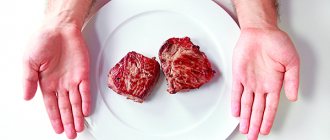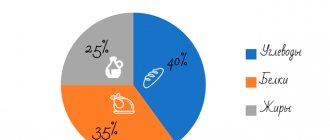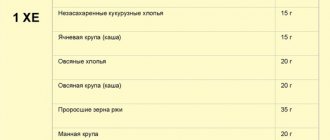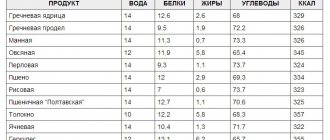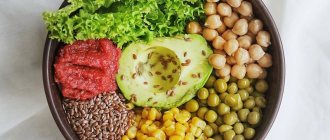The energy value of foods, or calorie content, refers to the amount of energy (kcal and kJ) that is produced by the human body when digesting foods eaten.
Nutritional value is measured in calories or joules. Ideal values are derived in the laboratory using a special device - a calorimeter. The measurement process is as follows: food is placed in the device and burned, measuring the amount of heat released. It has been scientifically established that one calorie is enough to raise the temperature of a gram of water by a degree. It has now become common practice to measure calories in kilocalories. That is, such a unit is spent on heating not a gram, but a kilogram of water.
Nature has it in such a way that the human body is not able to absorb all nutrients. Thus, proteins are absorbed only by 92%, carbohydrates by 98%, and fats by 95%.
Who needs to count calories and why?
The term “calories” was coined in 1918 by American nutritionist Lulu Hunt Peters. Since then, the developed system for calculating the nutritional properties of foods has not lost popularity.
From food a person receives the energy necessary for the functioning of the body. Each product consumed has its own calorie content. Counting is important for meeting your daily energy intake.
If the calorie content of the daily menu is too low, too little energy comes from food, loss of strength and apathy occur, dizziness and fainting are possible. The body experiences stress and often begins to store nutrients for future use, creating fat reserves. A clear excess of calories leads to the conversion of unspent energy into fats and contributes to the appearance of excess weight.
With the correct ratio of BJU and systematic training, body weight will increase due to muscle tissue. In this case, the extra calories will contribute to muscle gain.
It is recommended to count calories:
- Those who want to lose weight : a lack of calories leads to the fact that body weight decreases from the waste of fat reserves produced by the body to cover the energy deficit;
- Those seeking to build muscle : an excess of calories guarantees an increase in body weight; you can achieve growth not in the fat layer, but in muscles, by consuming a sufficient amount of protein and regularly training in the gym;
- For adherents of a healthy lifestyle , determined to maintain their existing physical shape: a balance of calories received and spent is necessary to maintain normal weight, and the optimal ratio of proteins, fats and carbohydrates will make nutrition complete, ensuring the healthy functioning of the body.
How to calculate the energy content of a diet
Those who are going to lose weight, or vice versa, build muscle mass, need to take into account every bite eaten and record it in a diary. Sometimes it is not clear from the information on the label what volume the calorie content is for.
For example, a bottle of milk says that it contains 3% protein, 2.5% fat, 4.7% carbohydrates, 53 kcal. We check the number of calories per 100 ml: 3*4.1+2.5*9.3+4.7*4.1=54.8.
Therefore, the nutritional value of 0.1 liter of milk is indicated on the package. If, after compiling the diet, it turns out that you need to add 148 calories, this can be done by adding 148/53*100=280 ml of milk.
Algorithm for calculating KBJU for weight maintenance
To organize proper nutrition and maintain your existing weight, if you are completely satisfied with it, it is important to calculate the daily calorie intake and the percentage of proteins, fats and carbohydrates.
Calorie content
will help determine your daily calorie intake .
Step 1. Calculate your basal metabolic rate.
Basic metabolism is the number of calories that ensures the normal functioning of the body in a state of absolute rest.
For men: Basal metabolic rate = 88.36 + (13.4 x weight, kg) + (4.8 x height, cm) - (5.7 x age, years).
For women: Basal metabolic rate = 447.6 + (9.2 x weight, kg) + (3.1 x height, cm) - (4.3 x age, years).
Step 2. Take into account the activity coefficient.
- 1.2 - minimal (no activity at all, sedentary work, sedentary lifestyle);
- 1.375 – low (light physical activity 1-3 times a week);
- 1.55 - average (workouts, active walks, physical work 4-5 times a week);
- 1.725 – high (training 6-7 days a week);
- 1.9 - very high (several training sessions a day, the usual regimen for athletes before competitions).
Step 3. Multiply the first digit by the desired coefficient.
Having carried out all the simple manipulations, we will get the result to maintain the existing weight.
Eg:
- A 30 year old man with a height of 172 cm and a weight of 80 kg, exercises 4 times a week, should consume daily (88.36 + (13.4 x 80) + (4.8 x 172) - (5.7 x 30)) x 1.55 = 2814 kcal.
- A 32-year-old woman with a height of 158 and a weight of 50 kg, attends 3 light workouts per week, should consume daily: (447.6 + (9.2 x 50) + (3.1 x 158) - (4.3 x 32) ) x 1.375 = 1732 kcal.
Find out how to reduce the caloric content of your usual diet here.
Calculation of BZHU
You can eat only sandwiches, stay within the calorie limit and lose excess weight. But you will have to forget about body quality and muscle tone. And health will deteriorate in the foreseeable future.
To get the figure of your dreams and avoid health problems, a person needs a balanced diet:
- Proteins act as building materials for all cells, and therefore for organs and muscles;
- Complex carbohydrates supply the body with energy and regulate the gastrointestinal tract;
- Fats regulate hormonal levels and promote the absorption of vitamins and microelements.
Standard BZHU ratio scheme for maintaining current weight (as a percentage): 30 / 20 / 50.
- 1 g protein = 4 kcal;
- 1 g fat = 9 kcal;
- 1 g carbohydrates = 4 kcal.
For example, with a norm of 2814 kcal per day:
- protein (30%) = 844 kcal / 4 = 211 g;
- fat (20%) = 563 kcal / 9 = 62.5 g;
- carbohydrates (50%) = 1407 kcal / 4 = 352 g.
At a norm of 1732 kcal:
- protein (30%) = 520 kcal / 4 = 130 g;
- fat (20%) = 346 kcal / 9 = 38 g;
- carbohydrates (50%) = 866 kcal / 4 = 216.5 g.
Table of BJU in food products
After determining the caloric content of the diet, you should make a list of dishes that will meet your goals. Calculating BJU in food is another effective assistant in the fight against excess weight. The calculator will help you organize a balanced diet, taking into account your personal nutritional value of foods.
When determining the calorie content of a particular dish, you should be guided only by individual indicators. The norm of BZHU per day is different for women and men. Therefore, there is no universal diet for the whole family. For example, for a woman 35 years old, weighing 70 kg and height 160 cm, leading a sedentary lifestyle, the energy value of food should be in the range of 1365 - 1536 kcal. At the same time, the BJU for weight loss for a man aged 37 years, weighing 80 kg and height 180 cm, will be 1959 - 2204 kcal, with a daily intake of proteins 146 grams, fats 77 grams, carbohydrates 209 grams. Thus, the female body requires less energy. Therefore, you can periodically resort to mono-diets (for example, buckwheat). A man must include meat, fish, dairy products, vegetable and animal fats in his diet. Otherwise, poor health and sleep disturbances become a constant companion to the complex process of losing weight.
A table of proteins, fats and carbohydrates in food will help you create a tasty and healthy menu for every adult family member. Choose your favorite dishes that fit best into your weight loss program and stay in shape without painful starvation.
| Milk and dairy products | Squirrels | Fats | Carbohydrates | Kcal |
| Brynza (cow's milk cheese) | 17,9 | 20,1 | 0,0 | 260 |
| Natural yogurt. 2% fat. | 4,3 | 2 | 6,2 | 60 |
| Kefir 3.2% fat | 2,8 | 3,2 | 4,1 | 56 |
| Kefir 1% low-fat | 2,8 | 1 | 4 | 40 |
| Milk 3.2% | 2,9 | 3,2 | 4,7 | 59 |
| Milk 2.5% | 2,8 | 2,5 | 4,7 | 52 |
| Condensed milk without sugar | 6,6 | 7,5 | 9,4 | 131 |
| Condensed milk with sugar | 7,2 | 8,5 | 56 | 320 |
| Whole milk powder | 26 | 25 | 37,5 | 476 |
| Yogurt 2.5% | 2,9 | 2,5 | 4,1 | 53 |
| Ryazhenka 2.5% | 2,9 | 2,5 | 4,2 | 54 |
| Cream 10% (low-fat) | 3 | 10 | 4 | 118 |
| Cream 20% (medium fat content) | 2,8 | 20 | 3,7 | 205 |
| Sour cream 10% (low-fat) | 3 | 10 | 2,9 | 115 |
| Sour cream 20% (medium fat content) | 2,8 | 20 | 3,2 | 206 |
| Dutch cheese | 26 | 26,8 | 0,0 | 352 |
| Processed cheese | 16,8 | 11,2 | 23,8 | 257 |
| Poshekhonsky cheese | 26 | 26,5 | 0,0 | 350 |
| Russian cheese | 24,1 | 29,5 | 0,3 | 363 |
| Swiss cheese | 24,9 | 31,8 | 0,0 | 396 |
| Curd | 7,1 | 23 | 27,5 | 341 |
| Low-fat cottage cheese | 16,5 | 0,0 | 1,3 | 71 |
| Cottage cheese 5% low-fat | 17,2 | 5 | 1,8 | 121 |
| Cottage cheese 9% semi-fat | 16,7 | 9 | 2 | 159 |
| Bread and bakery products | Squirrels | Fats | Carbohydrates | Kcal |
| Baranki | 16 | 1 | 0,0 | 366 |
| 1st grade wheat flour | 10,6 | 1,3 | 67,6 | 331 |
| Wheat flour 2nd grade | 11,7 | 1,8 | 63,7 | 324 |
| Wheat flour variety | 10,3 | 1,1 | 68,9 | 334 |
| Seeded rye flour | 6,9 | 1,4 | 67,3 | 304 |
| Rusks for tea | 10 | 2,3 | 73,8 | 397 |
| Drying poppy seeds | 11,3 | 4,4 | 70,5 | 372 |
| Wheat bread | 8,1 | 1 | 48,8 | 242 |
| Rye bread | 13 | 3 | 40 | 250 |
| Sliced loaf | 7,5 | 2,9 | 50,9 | 264 |
| Loaf of Moscow Region | 7,5 | 2,6 | 50,6 | 261 |
| Fats, butter and margarine | Squirrels | Fats | Carbohydrates | Kcal |
| Confectionery fat | 0,0 | 99,8 | 0,0 | 897 |
| Mayonnaise Provencal | 3,1 | 67 | 2,6 | 624 |
| Table margarine 40% | 0,0 | 40 | 0,0 | 360 |
| Milk margarine | 0,3 | 82 | 1 | 743 |
| Vegetable oil | 0,0 | 99 | 0,0 | 899 |
| Butter 72.5% | 1 | 72,5 | 1,4 | 662 |
| Butter 82% | 0,7 | 82 | 0,7 | 740 |
| Palm oil | 0,0 | 99,9 | 0,0 | 899 |
| Cereals | Squirrels | Fats | Carbohydrates | Kcal |
| Hercules | 12,5 | 6,2 | 61 | 352 |
| Buckwheat (done) | 9,5 | 2,3 | 65,9 | 306 |
| Buckwheat kernels (buckwheat) | 12,6 | 3,3 | 62,1 | 313 |
| Corn grits | 8,3 | 1,2 | 75 | 337 |
| Semolina | 10,3 | 1 | 67,4 | 328 |
| Oat groats | 12,3 | 6,1 | 59,5 | 342 |
| Pearl barley | 9,3 | 1,1 | 73,7 | 320 |
| Wheat groats | 11,5 | 1,3 | 62 | 316 |
| Millet cereal | 11,5 | 3,3 | 69,3 | 348 |
| White rice | 6,7 | 0,7 | 78,9 | 344 |
| Oatmeal | 12,5 | 6 | 64,9 | 363 |
| Barley | 10,4 | 1,3 | 66,3 | 324 |
| Vegetables | Squirrels | Fats | Carbohydrates | Kcal |
| Eggplant | 1,2 | 0,1 | 4,5 | 24 |
| Swede | 1,2 | 0,1 | 7,7 | 37 |
| Green peas | 5 | 0,2 | 13,8 | 73 |
| Green bean | 4 | 0,0 | 4,3 | 32 |
| Zucchini | 0,6 | 0,3 | 4,6 | 24 |
| White cabbage | 1,8 | 0,1 | 4,7 | 27 |
| Red cabbage | 1,8 | 0,0 | 7,6 | 24 |
| Cauliflower | 2,5 | 0,3 | 5,4 | 30 |
| Potato | 2 | 0,4 | 16,1 | 76 |
| Green onion (feather) | 1,3 | 0,0 | 4,6 | 19 |
| Leek | 2 | 0,0 | 8,2 | 33 |
| Bulb onions | 1,4 | 0,0 | 10,4 | 47 |
| Carrot | 1,3 | 0,1 | 6,9 | 32 |
| Ground cucumbers | 0,8 | 0,1 | 2,8 | 15 |
| Greenhouse cucumbers | 0,7 | 0,0 | 1,8 | 10 |
| Sweet yellow pepper | 1,3 | 0,0 | 5,3 | 27 |
| Sweet green pepper | 1,3 | 0,0 | 6,9 | 33 |
| Sweet red pepper | 1,3 | 0,0 | 5,3 | 27 |
| Parsley (greens) | 3,7 | 0,0 | 8,1 | 45 |
| Parsley (root) | 1,5 | 0,0 | 11 | 47 |
| Rhubarb (petiole) | 0,7 | 0,0 | 2,9 | 16 |
| Radish | 1,2 | 0,1 | 3,4 | 19 |
| Radish | 1,9 | 0,0 | 7 | 34 |
| Salad | 1,5 | 0,0 | 2,2 | 14 |
| Beet | 1,5 | 0,1 | 8,8 | 43 |
| Tomatoes | 1,1 | 0,2 | 3,7 | 20 |
| Cheremsha | 2,4 | 0,1 | 6,5 | 34 |
| Garlic | 6,5 | 0,5 | 29,9 | 143 |
| Spinach | 2,9 | 0,3 | 2 | 22 |
| Sorrel | 1,5 | 0,0 | 2,9 | 19 |
| Fruits | Squirrels | Fats | Carbohydrates | Kcal |
| Apricots | 0,9 | 0,0 | 9 | 44 |
| Quince | 0,6 | 0,0 | 9,8 | 40 |
| Cherry plum | 0,2 | 0,0 | 6,9 | 27 |
| A pineapple | 0,4 | 0,0 | 10,6 | 49 |
| Bananas | 1,5 | 0,0 | 21,8 | 95 |
| Cherry | 0,8 | 0,0 | 11,3 | 49 |
| Pomegranate | 0,9 | 0,0 | 11,8 | 52 |
| Pear | 0,4 | 0,0 | 10,7 | 42 |
| Figs | 0,7 | 0,0 | 13,9 | 56 |
| Peaches | 0,9 | 0,0 | 10,4 | 44 |
| Garden plum | 0,8 | 0,0 | 9,9 | 43 |
| Dates | 2,5 | 0,0 | 72,1 | 281 |
| Persimmon | 0,5 | 0,0 | 15,9 | 62 |
| Cherries | 1,1 | 0,0 | 12,3 | 52 |
| Apples | 0,4 | 0,0 | 11,3 | 46 |
| Orange | 0,9 | 0,0 | 8,4 | 38 |
| Grapefruit | 0,9 | 0,0 | 7,3 | 35 |
| Lemon | 0,9 | 0,0 | 3,6 | 31 |
| Mandarin | 0,8 | 0,0 | 8,6 | 38 |
| Grape | 0,4 | 0,0 | 17,5 | 69 |
| Blackberry | 2 | 0,0 | 5,3 | 33 |
| Strawberries | 1,8 | 0,0 | 8,1 | 41 |
| Cranberry | 0,5 | 0,0 | 4,8 | 28 |
| Gooseberry | 0,7 | 0,0 | 9,9 | 44 |
| Raspberries | 0,8 | 0,0 | 9 | 41 |
| White currant | 0,3 | 0,0 | 8,7 | 39 |
| Black currant | 1,0 | 0,0 | 8,0 | 40 |
| Blueberry | 1,1 | 0,0 | 8,6 | 40 |
| Fresh rosehip | 1,6 | 0,0 | 24 | 101 |
| Dried rose hips | 4,0 | 0,0 | 60 | 253 |
| Dried fruits | Squirrels | Fats | Carbohydrates | Kcal |
| Dried apricots | 5 | 0,0 | 67,5 | 278 |
| Dried apricots | 5,2 | 0,0 | 65,9 | 272 |
| Raisins with pit | 1,8 | 0,0 | 70,9 | 276 |
| Raisins sultanas | 2,3 | 0,0 | 71,2 | 279 |
| Cherry | 1,5 | 0,0 | 73 | 292 |
| Pear | 2,3 | 0,0 | 62,1 | 246 |
| Peaches | 3,0 | 0,0 | 68,5 | 275 |
| Prunes | 2,3 | 0,0 | 65,6 | 264 |
| Apples | 3,2 | 0,0 | 68 | 273 |
| Legumes | Squirrels | Fats | Carbohydrates | Kcal |
| Beans | 6 | 0,1 | 8,3 | 58 |
| Peas | 23 | 1,6 | 57,7 | 323 |
| Whole peas | 23 | 1,2 | 53,3 | 303 |
| Soybeans | 34,9 | 17,3 | 26,5 | 395 |
| Beans | 22,3 | 1,7 | 54,5 | 309 |
| Lentils | 24,8 | 1,1 | 53,7 | 310 |
| Mushrooms | Squirrels | Fats | Carbohydrates | Kcal |
| White fresh | 3,2 | 0,7 | 1,6 | 25 |
| White dried | 27,6 | 6,8 | 10 | 209 |
| Fresh boletus | 2,3 | 0,9 | 3,7 | 31 |
| Fresh boletuses | 3,3 | 0,5 | 3,4 | 31 |
| Meat, poultry and offal | Squirrels | Fats | Carbohydrates | Kcal |
| Mutton | 16,3 | 15,3 | 0,0 | 203 |
| Beef | 18,9 | 12,4 | 0,0 | 187 |
| horsemeat | 20,2 | 7 | 0,0 | 143 |
| Rabbit | 20,7 | 12,9 | 0,0 | 199 |
| Pork lean | 16,4 | 27,8 | 0,0 | 316 |
| Pork is fatty | 11,4 | 49,3 | 0,0 | 489 |
| Veal | 19,7 | 1,2 | 0,0 | 90 |
| Beef liver | 17,4 | 3,1 | 0,0 | 98 |
| Beef Kidneys | 12,5 | 1,8 | 0,0 | 66 |
| Beef Udder | 12,3 | 13,7 | 0,0 | 173 |
| Beef Heart | 15 | 3 | 0,0 | 87 |
| Beef Tongue | 13,6 | 12,1 | 0,0 | 163 |
| Pork kidneys | 13 | 3,1 | 0,0 | 80 |
| Pork liver | 18,8 | 3,6 | 0,0 | 108 |
| Pork heart | 15,1 | 3,2 | 0,0 | 89 |
| Pork tongue | 14,2 | 16,8 | 0,0 | 208 |
| Geese | 16,1 | 33,3 | 0,0 | 364 |
| Turkey | 21,6 | 12 | 0,8 | 197 |
| Chickens | 20,8 | 8,8 | 0,6 | 165 |
| Chickens | 18,7 | 7,8 | 0,4 | 156 |
| Ducks | 16,5 | 61,2 | 0,0 | 346 |
| Sausage | Squirrels | Fats | Carbohydrates | Kcal |
| Boiled sausage Diabetic | 12,1 | 22,8 | 0,0 | 254 |
| Boiled sausage Dietary | 12,1 | 13,5 | 0,0 | 170 |
| Boiled sausage Doctorskaya | 13,7 | 22,8 | 0,0 | 260 |
| Boiled sausage Lyubitelskaya | 12,2 | 28 | 0,0 | 301 |
| Boiled sausage Milk | 11,7 | 22,8 | 0,0 | 252 |
| Boiled sausage Separate | 10,1 | 20,1 | 1,8 | 228 |
| Boiled veal sausage | 12,5 | 29,6 | 0,0 | 316 |
| Pork sausages | 10,1 | 31,6 | 1,9 | 332 |
| Dairy sausages | 12,3 | 25,3 | 0,0 | 277 |
| Russian sausages | 12 | 19,1 | 0,0 | 220 |
| Pork sausages | 11,8 | 30,8 | 0,0 | 324 |
| Boiled-smoked Amateur | 17,3 | 39 | 0,0 | 420 |
| Boiled-smoked Cervelat | 28,2 | 27,5 | 0,0 | 360 |
| Semi-smoked Krakow | 16,2 | 44,6 | 0,0 | 466 |
| Semi-smoked Minsk | 23 | 17,4 | 2,7 | 259 |
| Semi-smoked Poltavskaya | 16,4 | 39 | 0,0 | 417 |
| Semi-smoked Ukrainian | 16,5 | 34,4 | 0,0 | 376 |
| Raw smoked Amateur | 20,9 | 47,8 | 0,0 | 514 |
| Raw smoked Moscow | 24,8 | 41,5 | 0,0 | 473 |
| Canned meat and smoked meats | Squirrels | Fats | Carbohydrates | Kcal |
| Beef stew | 16,8 | 18,3 | 0,0 | 232 |
| Pork stew | 14,9 | 32,2 | 0,0 | 349 |
| Raw smoked brisket | 7,6 | 66,8 | 0,0 | 632 |
| Raw smoked loin | 10,5 | 47,2 | 0,0 | 467 |
| Ham | 22,6 | 20,9 | 0,0 | 279 |
| Eggs | Squirrels | Fats | Carbohydrates | Kcal |
| Chicken egg | 12,7 | 10,9 | 0,7 | 157 |
| Egg powder | 45 | 37,3 | 7,1 | 542 |
| Protein powder | 73,3 | 1,8 | 7 | 336 |
| Dry yolk | 34,2 | 52,2 | 4,4 | 623 |
| Quail egg | 11,9 | 13,1 | 0,6 | 168 |
| Fresh fish and seafood | Squirrels | Fats | Carbohydrates | Kcal |
| Pink salmon | 20,5 | 6,5 | 0,0 | 142 |
| Flounder | 16,5 | 1,8 | 0,0 | 83 |
| crucian carp | 17,7 | 1,8 | 0,0 | 112 |
| Carp | 16 | 5.6 | 0,0 | 96 |
| Chum salmon | 22 | 5.6 | 0,0 | 138 |
| Smelt | 15.4 | 4.5 | 0,0 | 102 |
| Bream | 17.1 | 4.1 | 0,0 | 105 |
| Salmon | 20.8 | 15.1 | 0,0 | 219 |
| Macrurus | 13.2 | 0.8 | 0,0 | 60 |
| Pollock | 15.9 | 0.7 | 0,0 | 70 |
| capelin | 13.4 | 11.5 | 0,0 | 157 |
| Navaga | 16.1 | 1 | 0,0 | 73 |
| Burbot | 18.8 | 0.6 | 0,0 | 81 |
| Sea bass | 17.6 | 5.2 | 0,0 | 117 |
| River perch | 18.5 | 0.9 | 0,0 | 82 |
| Sturgeon | 16.4 | 10.9 | 0,0 | 164 |
| Halibut | 18.9 | 3 | 0,0 | 103 |
| Blue whiting | 16.1 | 0.9 | 0,0 | 72 |
| Carp | 18.4 | 5.3 | 0,0 | 121 |
| Large saury | 18.6 | 20.8 | 0,0 | 262 |
| Small saury | 20.4 | 0.8 | 0,0 | 143 |
| Salaka | 17.3 | 5.6 | 0,0 | 121 |
| Herring | 17.7 | 19.5 | 0,0 | 242 |
| Whitefish | 19 | 7.5 | 0,0 | 144 |
| Mackerel | 18 | 9 | 0,0 | 153 |
| Som | 16.8 | 8.5 | 0,0 | 144 |
| Horse mackerel | 18.5 | 5 | 0,0 | 119 |
| Sterlet | 17 | 6.1 | 0,0 | 320 |
| Zander | 19 | 0.8 | 0,0 | 83 |
| Cod | 17.5 | 0.6 | 0,0 | 75 |
| Tuna | 22,7 | 0,7 | 0,0 | 96 |
| coal fish | 13.2 | 11.6 | 0,0 | 158 |
| Sea eel | 19.1 | 1.9 | 0,0 | 94 |
| Acne | 14.5 | 30.5 | 0,0 | 333 |
| Hake | 16.6 | 2.2 | 0,0 | 86 |
| Pike | 18.4 | 0.8 | 0,0 | 82 |
| Ide | 18.2 | 1,0 | 0,0 | 81 |
| Cod liver | 4,2 | 65,7 | 0,0 | 613 |
| Squid | 18 | 0,3 | 0,0 | 75 |
| Crab | 16 | 0,5 | 0,0 | 69 |
| Shrimp | 18 | 0,8 | 0,0 | 83 |
| Sea kale | 0,8 | 0,2 | 3 | 5 |
| Nuts | Squirrels | Fats | Carbohydrates | Kcal |
| Hazelnut | 16,1 | 66,9 | 9,9 | 704 |
| Almond | 18,6 | 57,7 | 13,6 | 645 |
| Walnut | 15,2 | 61,3 | 10,2 | 648 |
| Peanut | 26,3 | 45,2 | 9,7 | 548 |
| sunflower seed | 20,7 | 52,9 | 5 | 578 |
| Sweets | Squirrels | Fats | Carbohydrates | Kcal |
| Honey | 0,8 | 0,0 | 80,3 | 308 |
| Marshmallow | 0,8 | 0,0 | 78,3 | 299 |
| Marmalade | 4,3 | 0,1 | 77,7 | 296 |
| Caramel | 0,0 | 0,1 | 77,7 | 296 |
| Chocolate candies | 4,3 | 39,5 | 54,2 | 596 |
| Paste | 0,5 | 0,0 | 80,4 | 305 |
| Granulated sugar | 0,0 | 0,0 | 99,5 | 374 |
| Sunflower halva | 11,6 | 29,7 | 54 | 516 |
| Dark chocolate | 6,9 | 35,3 | 52,6 | 540 |
| Milk chocolate | 6,9 | 35,7 | 52,4 | 547 |
| Waffles with French fillings | 3,2 | 2,8 | 80,9 | 350 |
| Waffles with fat fillings | 3,4 | 30,2 | 64,7 | 539 |
| Tube cake with cream | 1,7 | 25,2 | 50,9 | 454 |
| Airy cake | 3,1 | 16,3 | 68,5 | 419 |
| Gingerbread | 5,8 | 6,5 | 71,6 | 364 |
| Assorted cake | 4,7 | 15 | 36 | 294 |
| Cake Prague | 4,6 | 26,5 | 65,1 | 517 |
How to count KBJU for weight loss or weight gain
To lose weight, a calorie deficit is created: the daily norm of KBZHU is reduced by 10-20%, depending on the amount of extra pounds.
It is dangerous to create a deficit above 20% even with a lot of excess weight; this is fraught with serious health problems.
One of the BJU percentage schemes recommended by experts for weight loss is: 40 / 35 / 25.
- Let's consider the norm of KBZHU using the example of a woman who wants to lose weight, who is still 32 years old, height 158 cm, but her weight is already 65 kg, she trains 3 times a week:
Using the above formula, we calculate the daily calorie intake: 1922 kcal.
Subtract 10-20%.
To lose weight without harm to health, our heroine should maintain calorie content in the range of 1538-1730 kcal.
Of them:
- protein (40%) = 615-692 kcal = 154-173 g;
- fat (35%) = 538-605 kcal = 59-67 g;
- carbohydrates (25%) = 385-433 kcal = 96-108 g.
To gain muscle mass, the daily calorie intake needs to be increased by 10-20%.
The percentage of BJU recommended by experts for weight loss: 30 / 25 / 45.
- The KBZH norm for a 30-year-old man with a height of 172 cm and a weight of 60 kg, who goes to the gym 4 times a week in order to build muscle:
Daily calorie intake: 2398 kcal.
Add 10-20%.
To achieve the goal, a man must consume from 2638 to 2878 kcal every day.
Of them:
- protein (30%) = 791-863 kcal = 198-215 g;
- fat (25%) = 660-720 kcal = 73-80 g;
- carbohydrates (45%) = 1187-1295 kcal = 297-324 g.
Don’t forget, recalculation of the KBZHU norm must be done every ±5 kg. Then the transition to a new nutritional system will be as smooth and painless as possible for the body.
What influences changes in energy consumption
Energy costs are highest in children, adolescents and young people. Children and adolescents are capable of burning up to 3,000 kilocalories daily.
Pregnant women and nursing mothers also expend more energy. Therefore, in the first and third trimester, they should consume 100 kilocalories more than usual, and in the third - by 200. Women who are breastfeeding need to increase their daily caloric intake by 500 units.
Energy expenditure usually decreases with age. After 40 years, in the first decade the body spends less energy by 5%, after 60 years – by 10%. For this reason, the caloric content of the diet should decrease over the years. Optimal indicators:
- for women - about 1600 - 1700 kcal (maximum - 3700);
- for men - approximately 2000 - 2200 kcal (maximum limit - 4800).
Not everyone understands the importance of counting the calories in their diet. And completely in vain. The same amount of food may differ in the number of calories, and this is an important aspect for maintaining weight, maintaining your health and well-being.
How to count KBJU dishes
Calculating the calorie content of a finished dish at a certain level of dexterity is easy and accessible to everyone.
Let's look at the calculation of KBZHU using a simple example: let's cook dietary crumbly buckwheat porridge.
The calorie content of 100 g of buckwheat is 340 kcal, BZHU: 13 / 3.5 / 64.
From 200 g of cereal (calorie content 680 kcal) you get 400 g of ready-made porridge (same calorie content 680 kcal), BZHU: 26 / 7 / 128.
Formula for calculating calories in one serving of a prepared dish:
BZHU is considered similarly.
For example: By eating a 150-gram portion of delicious buckwheat at a time without oil and other additives, you will get
680 kcal / 400 g x 150 g = 250 kcal, BZHU 9.75 / 2.63 / 48.
- To calculate the calorie content of a complex dish made from a large number of ingredients, you need to weigh all the ingredients before cooking, determine their energy capacity and add up the results.
The calorie content of a vegetable salad is calculated as follows:
tomatoes 300 g, 54 kcal, BJU: 2.64 / 0.6 / 8.07;
cucumbers 300 g, 45 kcal, BJU: 2.4 / 0.3 / 8.4;
lettuce 100 g, 15 kcal, BJU: 1.36 / 0.15 / 2.79;
radish 50 g, 10 kcal, BJU: 0.6 / 0.05 / 1.7;
olive oil 15 g, 135 kcal, BJU: 0 / 14.97 / 0.
Total weight 765 g, total calorie content 259 kcal, BJU: 7 / 16.07 / 20.96.
The calorie content of a 200-gram serving will be: 259 kcal / 765 g x 200 g = 68 kcal
Proteins: 7 g / 765 g x 200 g = 1.83 g,
Fat: 16.07 g / 765 g x 200 g = 4.2 g,
Carbohydrates: 20.96 g / 765 g x 200 g = 5.5 g.
It is important to note that when calculating, only the weight of the finished product is used, and not the total weight of all components.
As you can see, counting calories is not that difficult. The main thing is to start. Over time, you'll get used to weighing ingredients before cooking and portions before eating, and always keeping a calculator handy.
What is the energy value of carbohydrates, proteins and fats?
If we recalculate the calorie content of the main substances, we get:
- 4.1 kcal per gram of protein;
- 4.1 kcal per gram of carbohydrates;
- 9.29 kcal per gram of fat.
As you can see, the most high-calorie foods are fatty foods. In other words, if you eat 100 g of lard and the same amount of buckwheat porridge or turkey, then in the first case twice as much energy will be released.
Tips for those who want to calculate the daily calorie content of their diet as accurately as possible
- Keep a food diary where you write down all your meals, including snacks. Don't rely on your excellent memory, it often fails. All calories consumed must be recorded and accounted for. Only then will you get the most accurate result at the end of the day.
- Buy a kitchen scale; do not determine the weight of food by eye. Small errors result in a noticeable difference in the final calorie content of the daily diet.
- Weigh food before cooking.
- Consider the calorie content of butter, sauce, sugar and other auxiliary products in the dish.
- Place on the scale only that part of the product that will be directly consumed as food (boneless meat, pulp of fruits and vegetables without peels and seeds, eggs without shells).
- Don’t look for the calorie content of a multi-ingredient dish on the Internet and mobile apps, calculate it yourself. Before cooking, weigh the ingredients, calculate their energy value and add up the results. The final data will be more accurate.
- Try to avoid eating at food establishments. The calorie content of the dishes on the menu is very approximate. Only you can calculate the KBZHU for yourself as accurately as possible.
Norm for men and women per day for weight loss
When losing weight, the daily calorie intake for a woman and a girl should be at least 1100-1300 kcal. This amount of consumption can provide the female body with everything it needs.
But the daily calorie intake for a man’s weight loss is slightly higher - 1300-1600 kcal. It is extremely important to calculate the calorie content of the food you eat so that it contains not only proteins, but also complex carbohydrates. Under no circumstances should you give up entire food groups. This may have a negative impact on your well-being.
How to calculate the daily calorie intake for weight loss?
An online daily calorie calculator will help you understand what calorie intake you need to stay in shape, and will also make a calculation and help you understand how many calories per day you need to lose weight. In addition, you can calculate the norm yourself using calorie consumption tables and formulas.
For a person, the recommended daily calorie intake for weight loss is 20% less than the result you obtained from the above calculations (1200-1400 kcal). For a child (up to 10 years old), the average daily intake, when losing weight, fluctuates around 1800-2000 kcal, and for a teenager the recommended daily intake is 2300-2500 kcal.
Where to look for KBJU products
In order to correctly calculate the calorie content of your diet, it is important to know where you can find information about the calories and nutritional value of the foods you consume.
- Please read the product packaging carefully. The manufacturer always indicates accurate information on it.
- If the product does not have packaging, data on calorie content and nutrient content can be easily found on the Internet: there are a great many tables. By entering a query about the product you are interested in in the search bar, you will receive comprehensive information. For maximum reliability, compare results from several sources.
- Numerous mobile applications used for calorie counting already contain a wide list of products with calculated calorie values. Enjoy it for your health!
Example of a calorie table
Counting calories is a matter of habit. The troublesome and tedious process becomes easy and understandable over time. Start counting with simple products, gradually add complex recipes with many ingredients. One day you will bring your actions to automaticity. You no longer have to go on diets, giving up delicious food. You will receive aesthetic pleasure when looking at yourself in the mirror. And the body will thank you for your care with the smooth functioning of all vital organs.
Why the correct ratio of BZHU is so important for weight loss↑
The correct ratio of BZHU is very important for the body. By changing this ratio, you can productively adjust your weight up or down, build muscle more efficiently, “accelerate” your metabolism, or reduce body weight.
Diets don't work
It’s no wonder that “diet exhaustion” has become a commonly used phrase. Almost all “fast” diets involve avoiding fat consumption and reducing the amount of carbohydrates in the diet. Despite the apparent effect and several kilograms lost, this is a huge stress for the body. The body enters “economy mode” and is very reluctant to get rid of accumulated fat deposits, immediately compensating for losses with any excess received. As soon as the diet is finished, the kilograms that were lost will return with gain.
Properties of human fat
There is an opinion that the number of fat cells in the body is determined by a hereditary factor, such as eye or hair color. However, there is other information that refutes this opinion, and it lies in the fact that the number of fat cells in a child is determined by how the mother ate. It also became known that in obesity, fat cells can divide on their own, and then only surgical intervention can help overcome them.
Fat in the body is divided into several types: brown, subcutaneous and internal . The brown type of fat is needed so that the body can maintain the correct temperature. There is enough such fat in the body of infants - it protects them from hypothermia. Subcutaneous fat, as its name implies, is located directly under the skin and is the familiar cellulite. This is exactly the type of fat that we constantly struggle with. As for internal or visceral fat, it is deposited on the surface of human organs and inside them. Fat can grow into muscle tissue and even penetrate into the heart.
Together with the blood, excess fat circulates through the vessels, clogs them, and is deposited on the wall. It becomes difficult for blood to penetrate the body's cells, blood pressure rises, and possible malaise. Cholesterol plaques cause stroke and heart attack. Therefore, it is important to get rid of not only the fat that is visible to the naked eye, but also to free the internal organs from it. Despite the fact that the effects of different types of fat are different, their calorie content remains the same.
Daily norm of KBZHU
The determination of the norm is influenced by factors such as gender, weight, height, and level of physical activity. There is an average daily limit of elements for an adult.
The ratio of calories and dietary fat according to generally accepted standards: 2000 kcal = 90 g protein + 60 g fat + 250 g carbohydrates.
By paying attention to calories, we control our weight. By focusing on the balance of substances, we regulate metabolism and take care of our health.
The indicators are individual for each person. You can find out your numbers yourself using formulas, or by seeking help from a nutritionist for a more accurate analysis.
BJU consumption rate for different people
The table presents data that constitutes the values of daily calorie content and BJU norms, approximately calculated depending on body weight.
The table also takes into account the following activity groups:
- I - knowledge workers;
- II - work involving light physical labor;
- III - work involving moderate labor;
- IV - work associated with heavy physical labor;
- V - workers engaged in very heavy physical labor.
| Activity class | Weight | Women | Men | ||||||
| Calorie content, kcal | Proteins, g | Fats, g | Carbohydrates, g | Calorie content, kcal | Proteins, g | Fats, g | Carbohydrates, g | ||
| I | 40 kg | 1381 | 86 | 46 | 138 | 1581 | 99 | 61 | 158 |
| 50 kg | 1501 | 94 | 50 | 150 | 1700 | 106 | 66 | 170 | |
| 60 kg | 1621 | 122 | 54 | 162 | 1820 | 114 | 71 | 182 | |
| 70 kg | 1740 | 131 | 58 | 174 | 1940 | 121 | 75 | 194 | |
| 80 kg | 1861 | 140 | 62 | 186 | 2060 | 129 | 80 | 206 | |
| 90 kg | 1981 | 149 | 66 | 198 | 2180 | 136 | 85 | 218 | |
| 100 kg | 2101 | 158 | 70 | 210 | 2300 | 144 | 89 | 230 | |
| II | 40 kg | 1589 | 99 | 62 | 159 | 1818 | 114 | 71 | 182 |
| 50 kg | 1726 | 108 | 67 | 173 | 1955 | 122 | 76 | 196 | |
| 60 kg | 1864 | 117 | 72 | 186 | 2093 | 131 | 81 | 209 | |
| 70 kg | 2002 | 125 | 78 | 200 | 2231 | 139 | 87 | 223 | |
| 80 kg | 2139 | 134 | 83 | 214 | 2369 | 148 | 92 | 237 | |
| 90 kg | 2278 | 142 | 89 | 228 | 2507 | 157 | 97 | 251 | |
| 100 kg | 2416 | 151 | 94 | 242 | 2645 | 165 | 103 | 264 | |
| III | 40 kg | 1727 | 108 | 67 | 173 | 1976 | 123 | 77 | 198 |
| 50 kg | 1877 | 117 | 73 | 188 | 2126 | 133 | 83 | 213 | |
| 60 kg | 2026 | 127 | 79 | 203 | 2275 | 142 | 88 | 228 | |
| 70 kg | 2176 | 136 | 85 | 218 | 2425 | 152 | 94 | 243 | |
| 80 kg | 2326 | 145 | 90 | 233 | 2575 | 161 | 100 | 258 | |
| 90 kg | 2476 | 155 | 96 | 248 | 2725 | 170 | 106 | 272 | |
| 100 kg | 2626 | 164 | 102 | 263 | 2875 | 180 | 112 | 287 | |
| IV | 40 kg | 1957 | 122 | 76 | 196 | 2239 | 140 | 87 | 224 |
| 50 kg | 2127 | 133 | 83 | 213 | 2409 | 151 | 94 | 241 | |
| 60 kg | 2297 | 144 | 89 | 230 | 2579 | 161 | 100 | 258 | |
| 70 kg | 2466 | 154 | 96 | 247 | 2749 | 172 | 107 | 275 | |
| 80 kg | 2636 | 165 | 103 | 264 | 2918 | 182 | 113 | 292 | |
| 90 kg | 2806 | 175 | 109 | 281 | 3088 | 193 | 120 | 309 | |
| 100 kg | 2976 | 186 | 116 | 298 | 3258 | 204 | 127 | 325 | |
| V | 40 kg | 2187 | 137 | 85 | 219 | 2502 | 156 | 97 | 250 |
| 50 kg | 2377 | 149 | 92 | 238 | 2692 | 168 | 105 | 269 | |
| 60 kg | 2567 | 160 | 100 | 257 | 2882 | 180 | 112 | 288 | |
| 70 kg | 2757 | 172 | 107 | 276 | 3072 | 192 | 119 | 307 | |
| 80 kg | 2946 | 184 | 115 | 295 | 3262 | 204 | 127 | 326 | |
| 90 kg | 3136 | 196 | 122 | 314 | 3452 | 216 | 134 | 345 | |
| 100 kg | 3326 | 208 | 129 | 333 | 3641 | 228 | 142 | 364 | |
The values indicated in the table are very approximate, since height and age are averaged. In order to accurately calculate the daily calorie content and the ratio of BZHU, you need to independently make calculations using the above formula.
For weight loss
When losing weight, the caloric intake calculated to maintain weight will need to be adjusted. To do this, you need to determine the calorie corridor. The upper limit will be the calorie norm. To calculate the bottom, this number should be reduced by 15-20%.
You can't cut calories any further. This will cause your metabolism to slow down, making it much more difficult to lose weight.
The ratio of BZHU for losing excess weight, as already shown in the picture above, should be approximately this:
- proteins - 40-50%;
- fats - 30-40%;
- carbohydrates - 10-20%.
You can specifically determine the daily norms of macronutrients in grams by creating a menu, based on the calculated calorie content for weight loss. Products should be selected in such a way that the BJU ratio is maintained.
For gaining muscle mass
To grow muscles, your base caloric intake should be increased. You can add from 20 to 40% or even more to it.
But you shouldn’t dramatically increase your caloric intake. It is advisable to add 100-200 kcal daily.
The ratio of BZHU for muscle building should be approximately this:
- proteins - 25-35%;
- fats - 10-15%;
- carbohydrates - 40-60%.
This large amount of carbohydrates is needed to support the enormous energy expenditure of heavy weight training.
For children
The standards for consumption of BJU for children will be different. At a younger age, the ratio should be 1:1:3, at an older age - 1:1:4.
In addition, it is recommended to include more animal products in the child’s diet.
The table shows the daily value of calories and macronutrients for children of different ages.
| Age | Number of calories, kcal | Proteins, g | Fats, g | Carbohydrates, g |
| 1-1,5 | 1300 | 48 | 48 | 160 |
| 1,5-2 | 1500 | 53 | 53 | 192 |
| 3-4 | 1800 | 63 | 63 | 233 |
| 5-6 | 2000 | 72 | 72 | 252 |
| 7-10 | 2400 | 80 | 80 | 324 |
| 11-13 | 2850 | 96 | 96 | 382 |
| 14-17 (guys) | 3150 | 106 | 106 | 422 |
| 14-17 (girls) | 2750 | 93 | 93 | 367 |
It is advisable to at least approximately comply with these standards, since the child’s body is developing and needs nutrients to ensure growth.
Why follow BZHU
Attention to the composition of food will help to avoid or get rid of health problems, impaired functioning of the body, lack of energy, and a weakened immune system.
Poor nutrition leads to a constant feeling of hunger and inhibits weight loss. With a lack of necessary substances, metabolism begins to slow down. As a result, at the slightest deviation from the diet, the kilograms quickly add on.
Without observing the BJU ratio, the so-called “skinny fat” effect can occur - when the body looks loose, despite the appearance of thinness in clothes.
Counting nutrients allows you to keep all foods in your diet, even those that are “forbidden” in many diets. Weight loss is based on a reasonable ratio of substances and caloric restriction. Thanks to this approach, the risk of breakdowns is minimized, and healthy eating becomes a way of life.

